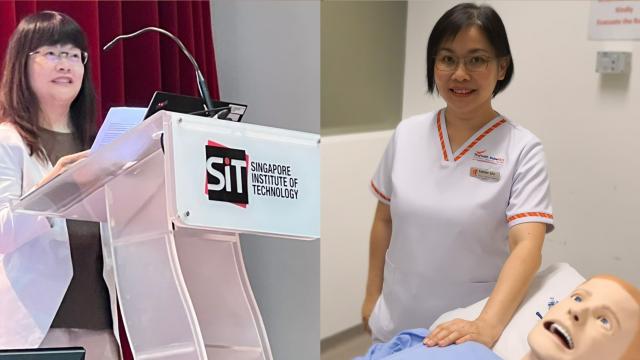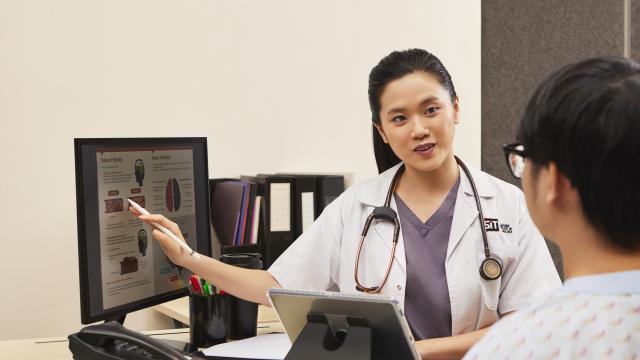There was no reason to be optimistic. For years, doctors and physiotherapists had gotten used to the bleak prognosis of severe spinal cord injury. Patients would most likely be permanently paralysed at the level below their injury. Those with complete spinal cord injury – the most severe injury category – would be unable to stand and walk for the rest of their lives.
Yet, when Dr Wan Kai Rui, a neurosurgeon from the National Neuroscience Institute (NNI) and Dr Valerie Ng, a rehabilitation doctor from Tan Tock Seng Hospital (TTSH), approached Associate Professor Wee Seng Kwee from SIT’s Health and Social Sciences Cluster proposing to change the status quo through a research project, A/Prof Wee was on board at once.
As a clinical physiotherapist working with neurological patients in TTSH, A/Prof Wee leverages his clinical expertise to develop customised rehabilitation programmes for individuals with spinal cord injuries. Guided by the belief in exploring the unknown to find better rehabilitation approaches and improve patient outcomes, he was also eager to incorporate research findings from the trial into SIT’s curriculum for his students to enhance their learning and inspire them to push boundaries.
Associate Professor Wee Seng Kwee is on a mission to help patients with severe spinal cord injury regain functional mobility. (Photo: Wee Seng Kwee)
The time was 2020. There was limited information about a spinal cord stimulator that, when implanted, could potentially boost signal transmission between the brain and paralysed limbs. There was much less guidance on the subsequent physical rehabilitation programme that would help patients regain movement.
“We were willing to dive in and explore, even if we ended up failing,” recalled A/Prof Wee, who is also a Senior Principal Physiotherapist at TTSH.
Three years on, with funding support from the National Medical Research Council and Ng Teng Fong Healthcare Innovation Programme, the project culminated in a clinical trial called RESTORES (RESToration Of Rehabilitative function with Epidural spinal Stimulation). The clinical trial is a collaboration between NNI, TTSH and the Agency for Science, Technology and Research (A*STAR), and it has since changed the lives of two patients for the better.
First of Its Kind Procedure in Asia
There are two components to the RESTORES trial. The two participants in the trial, Sam Subian and Asyraf Ghazali — both of whom were paralysed from the chest down from accidents between five and six years ago — were first implanted with a spinal cord stimulator in the lower back. It taps on the residual neural pathways that could still send signals from the brain down the spinal cord, to eventually reach the key lower limb muscles for standing and walking.
Next, they underwent seven months of intensive physiotherapy consisting of a wide range of techniques — motor imagery (the person imagines that he performs a movement without any actual movement), modified horse-riding therapy (hippotherapy) for training trunk control and balance, walking with wearable robotic exoskeleton suit (Ekso), overground walking with a ceiling hoist, and finally, taking steps with a wheeled walking frame (rollator frame).
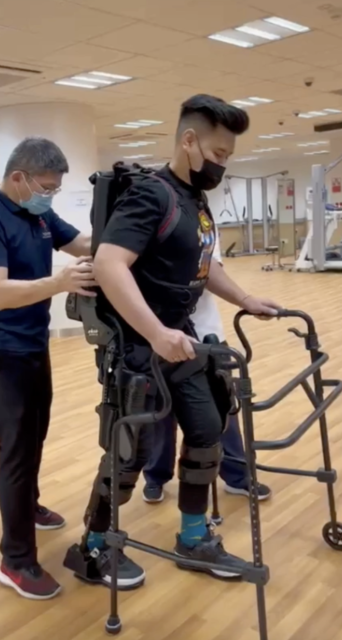
Asyraf walking with a wearable robotic exoskeleton suit. (Photo: Wee Seng Kwee)
Today, the two participants are able to stand up independently and walk 3 to 5 metres with a rollator walking frame under the supervision of their carers. It is a dramatic difference from the start of 2023, when they were completely paralysed and reliant on a wheelchair for moving around indoors and outdoors.
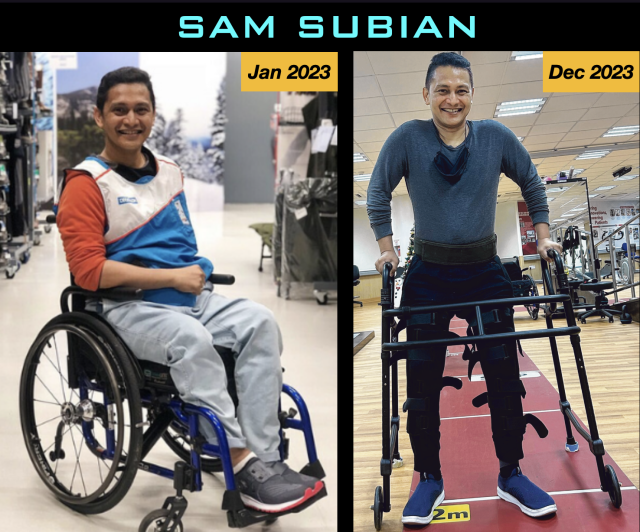
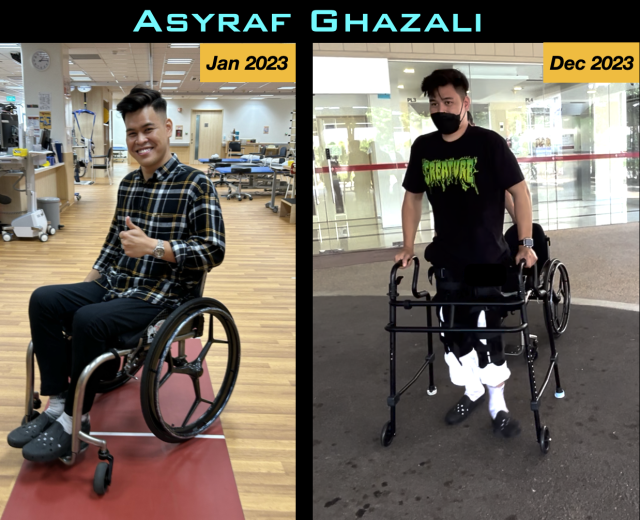
Through the RESTORES trial, Sam Subian and Asyraf Ghazali with severe complete thoracic spinal cord injury can stand up independently and walk 3 to 5 metres with the support of a rollator walking frame. (Photos: Wee Seng Kwee)
In a similar study in the United States previously, researchers could only get patients to move their toes after 6 to 9 months. In contrast, the RESTORES Team had achieved outcomes that went far beyond expectations.“This is the kind of outcome we are looking for, that we would be able to bring the impact out of the clinic into their real lives. One day, we hope that they may be able to progress to using elbow crutches and take walks outside with their family,” said A/Prof Wee.
When asked about RESTORES trial success factors at this juncture, A/Prof Wee turned the spotlight squarely on the participants.
"Despite their understanding of the research, we feared that there would be no improvement in functional mobility after seven months of rehabilitation as we didn't want to give them false hope. However, the patients believed in the trial and were willing to try new therapies. This is why we could advance the difficulty level of their rehabilitation exercises so quickly and assist them this far to achieve such a remarkable outcome.”
Their family members who accompanied them to the therapy clinic for seven months were also critical. Nonetheless, they provided them with strong emotional and psychological support. “These participants were fully supported on the entire journey, and that made a huge difference,” he said.The trial will be extended to a third participant in early 2024. In 2025, phase two of the trial will recruit 15 participants, which will include some participants with cervical spinal cord injury leading to paralysis of the upper and lower limbs.
Pushing the Frontiers of Rehabilitation
A/Prof Wee stressed that it is the potential to transform patients’ lives that has kept him going for the past 30 years, working as a clinical physiotherapist. However, the self-professed “true blue clinician” understands that to be able to improve care, he needs to bring his practice outside of hospital walls — to teach locally and globally, and conduct research projects like RESTORES.
“We need to discover new ways of providing therapy to improve patient outcomes. If we had stayed complacent with the existing rehabilitation care level for spinal cord injured patients, we wouldn’t have gotten RESTORES to this point,” said A/Prof Wee, whose paper on the RESTORES rehabilitation protocol is now under review by a medical journal.
Such breakthroughs also compel A/Prof Wee and fellow academicians to keep current with their university curriculum. “This year, when I get to the sub-module on spinal cord injury rehabilitation, I can bring in these new findings and videos of the patients we worked with to teach and inspire our students and faculty. I will also motivate my students to identify the current gaps in rehabilitation and encourage them to conduct research to explore innovative therapies for enhanced patient outcomes,” said A/Prof Wee.
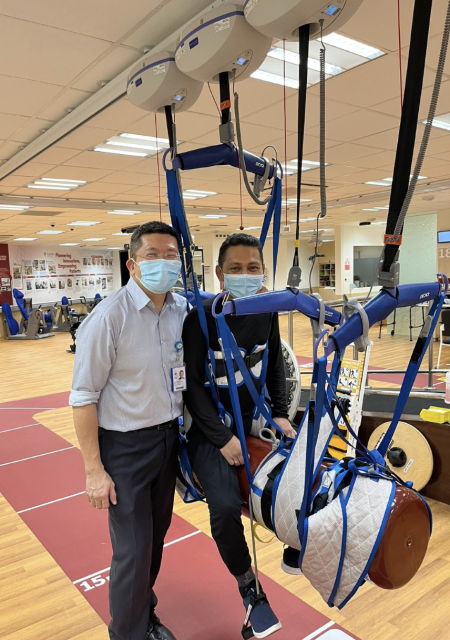
Associate Professor Wee Seng Kwee developed a simulated horse riding therapy for patients. (Photo: Wee Seng Kwee)
“With research, we improve treatment outcomes and share best clinical practices in the classroom and publications. Hopefully, such breakthroughs will also inspire our students to challenge the norm and explore new treatment techniques when they enter the workforce; hence, creating a ripple effect,” added A/Prof Wee.

